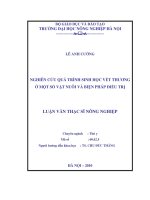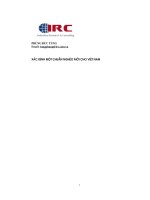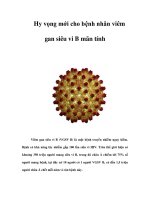Thuốc thảo dược: một hy vọng mới cho liệu pháp điều trị tự kỷ
Bạn đang xem bản rút gọn của tài liệu. Xem và tải ngay bản đầy đủ của tài liệu tại đây (347.16 KB, 3 trang )
J HerbMed Pharmacol. 2016; 5(3): 89-91.
Journal of HerbMed Pharmacology
Journal homepage:
Herbal medicines: a new hope for autism therapy
Sadegh Rezapour1, Mahmoud Bahmani2*, Omid Afsordeh2, Reza Rafieian3, Ali Sheikhian1
Razi Herbal Medicines Research Center, Lorestan University of Medical Sciences, Khorramabad, Iran
Clinical Microbiology Research Center, Ilam University of Medical Sciences, Ilam, Iran
3
Medical Plants Research Center, Shahrekord University of Medical Sciences, Shahrekord, Iran
1
2
ARTICLE INFO
ABSTRACT
Article Type:
Autism is a neurodevelopment disorder that causes disruption in communication, behavior and
social interaction, and influences all aspects of child development. Families of autistic children are
involved with it more than families of children with Down syndrome and mental disorders. The
causes of Autism include psychosocial, immune, genetic and biological parameters. So far there is
no effective drug treatment and rehabilitation for the treatment of autism. In this study, the most
important medicinal plants with neuroprotective effects on autism have been reported. Based on
the present study, medicinal herbs such as Zingiber officinale, Astragalus membranaceu, Ginkgo
biloba, Centella asiatica, Acorus calamus, Paeonia lactiflora, Lobelia inflata and Actaea racemosa
have neuroprotective effects and might be beneficial for this problem.
Mini Review
Article History:
Received: 22 February 2016
Accepted: 9 June 2016
Keywords:
Autism
Herbs
Phytotherapy
Implication for health policy/practice/research/medical education:
Oxidative stress is considered as an important factor in autism. Therefore, medicinal plants with antioxidant activity might be
beneficial in autism.
Please cite this paper as: Rezapour S, Bahmani M, Afsordeh O, Rafieian R, Sheikhian A. Herbal medicines: a new hope for
autism therapy. J HerbMed Pharmacol. 2016;5(3):89-91.
Introduction
Autism disorders are developmental disorders of the
nervous system that causes impairment in communication, behavior and social interaction (1). This disorder is
widespread and affects all aspects of child development,
so there is a need to evaluate all aspects of human performance including social skills, mobility, language, daily living skills, play, executive functions, the recognition social
and academic skills (2).
Families of autistic children are involved with it more
than families of children with Down syndrome and mental disorders (3). Children with autism have problems and
their families, especially mothers of children with autism,
suffer from the stress and the enormous psychological
problems (4).
According to the statistics, incidence of autism ratio in
male to female has been reported about 1: 3 to 1: 4 (5). In
the first year of a child’s life symptoms appear, but usually
it is not detected until 2 to 3 years of age (6). Psychosocial,
immune, genetic, biologic causes are considered in autism
(7). So far there is no choice drug for the treatment of autism, but drugs that are used are effective on behaviors
such as self-injury, neglect, aggression, repetitive and stereotyped behaviors, hyperactivity and sleep disorders. The
*Corresponding author: Mahmoud Bahmani;
Email:
drugs that are recommended to be used to treat symptoms
of autism include clonidine, naltrexone, lithium, drivers,
mega vitamins, thyroid hormones and antidepressants,
but none of them has significant effect (8,9).
Medicinal plants have been recently considered as a reliable source for preparation of new drugs for treatment of
various diseases (10-12). Medicinal herbs are plants that
one or some of their organs contain active ingredients and
are effective in various diseases (13-17). Medicinal herbs
as a medicinal source are usually available, inexpensive,
and effective. They generally have fewer adverse effects
than chemical drugs (18-23). Different plants have different properties and chemical compounds in plants mediate their effect on the human body (24-30). Recently medicinal plants have raised a new hope for the treatment
of autism. Hence, this paper aimed to introduce these
plants which have had promising effects on autism. Table
1 consists of a list of medicinal plants which have brought
neuro-protective effects on autistic disorder.
Discussion
It has been estimated that the cases of autism range from
more than one in 500 to one in 1000. It has been suggested
that environmental toxins and pollution might contribute
Rezapour S et al
Table 1. Medicinal plants with neuro-protective effects on autistic
disordera
Scientific Name
Zingiber officinale
Astragalus membranaceus
Ginkgo biloba
Centella asiatica
Acorus calamus
Paeonia lactiflora
Lobelia inflate
Actaea racemosa
a
Family Name
Zingiberaceae
Fabaceae
Ginkgoaceae
Apiaceae
Acoraceae
Paeoniaceae
Campanulaceae
Ranunculaceae
Part of Usage
Ginger root
Aerial part
Ginkgo leaf
Gotu kola leaf
Calamus root
Peony root
Lobelia leaf
Black cohosh root
7.
8.
9.
10.
References 31-41.
critically in this disease. Immunizations, viral infections,
antibiotics as well as nutrition are the other causal aspects. However, recent researches suggest the genetic ties
and suggest that the disorder presents prenatal. Oxidative stress is also considered as an important factor (42).
Therefore, the effects of medicinal plants in autism might
be partly due to their antioxidant activities.
Authors’ contributions
SR and MB prepared the first draft and RR edited it. All
read and confirmed the manuscript.
11.
12.
13.
14.
Conflict of interests
The authors declared no competing interests.
Ethical considerations
Ethical issues (including plagiarism, misconduct, data
fabrication, falsification, double publication or submission, redundancy) have been completely observed by the
authors.
15.
16.
Financial support
There was no financial support
References
1.
2.
3.
4.
5.
6.
90
Pervasive Developmental Disorders. In: American
Psychiatric Association, ed. Diagnostic and Statistical
Manual of Mental Disorders. 4th ed. Washington, DC:
American Psychiatric Association; 2000:70.
Gould E, Dixon DR, Najdowski AC, Smith MN, Tarbox
J. A review of assessments for determining the content of
early intensive behavioral intervention programs for autism
spectrum disorders. Res Autism Spectr Disord. 2011;5:
990-1002.
Mohammadi-Zade A, Pooretemad H, Maleck-Khosravi G.
The primary examination of effect of guided imagination
by music on reduction of depression, anxiety, & stress in
mothers with autistic children. J Res Fam. 2005;3:289-92.
Gray DE. High functioning autistic children and
the construction of “normal family life”. J Soc Med.
1997;44(8):1097-106.
Filipek PA, Accardo PJ, Baranek GT, Cook EH, Dawson G,
Gordon B, et al. The Screening and Diagnosis of Autistic
Spectrum Disorder. J Autism Dev Disord. 1999;29(6):43984.
Rapin I, Tuchman R. Autism: definition, neurobiology,
screening, diagnosis. Pediatr Clin North Am. 2008;55(5):
Journal of HerbMed Pharmacology, Volume 5, Number 3, July 2016
17.
18.
19.
20.
21.
22.
1129-46.
Filipek PA, Accardo PJ, Baranek GT, Cook EH Jr, Dawson
G, Gordon B, et al. The screening and diagnosis of autistic
spectrum disorders. J Autism Dev Disord. 1999;29(6):43984.
Sadok BJ, Sadok VA. Comprehensive textbook of psychiatry.
8th ed. Philadelphia: Williams & Wilking; 2005:3164-75.
Kaplan HI. Sadok BJ. Synopsis of psychiatry.10 th ed.
Lippincott. Philadelphia: Williams and Wilkins; 2007:1208
-22.
Sarrafchi A, Bahmani M, Shirzad H, Rafieian-Kopaei M.
Oxidative stress and Parkinson’s disease: new hopes in
treatment with herbal antioxidants. Curr Pharm Des. 2016;
22(2): 238-246.
Shayganni E, Bahmani M, Asgary S, Rafieian-Kopaei M.
Inflammaging and cardiovascular disease: management by
medicinal plants. Phytomedicine. 2015 Dec 3. pii: S09447113(15)00356-6.
Saki K, Bahmani M, Rafieian-Kopaei M. The effect of most
important medicinal plants on two important psychiatric
disorders (anxiety and depression)-a review. Asian Pac J
Trop Med. 2014;7(Suppl 1):34-42.
Rahimi-Madiseh M, Bahmani M, Karimian P, Rafieiankopaei M. Herbalism in Iran: a systematic review. Der
Pharma Chemica. 2016;8(2):36-42.
Taherikalani M, Hassanzadazar H, Bahmani M,
Baharvand-Ahmadi B, Rafieian-Kopaei M. Staphylococcus
phytotherapy: An overview on the most important Iranian
native medicinal plants effective on Staphylococcus aureus.
J Chem Pharm Sci. 2016;9(1):16-23.
Baharvand-Ahmadi B, Bahmani M, Naghdi N, Saki K,
Baharvand-Ahmadi S, Rafieian-Kopaei M. Review on
phytochemistry, therapeutic and pharmacological effects
of myrtus (Myrtus communis). Der Pharmacia Lettre.
2015;7(11):160-165.
Baharvand-Ahmadi B, Bahmani M, Rafieian-Kopaei
M. Review of the medicinal herbs effective on labor
and cesarean section pain in Iran. J Chem Pharm Sci.
2016;9(1):24-27.
Aleebrahim-Dehkordy E, Rafieian- Kopaei M, Bahmani
M. Study of antibacterial effect of total hydroalcoholic
extract of Thymus daenensis and Lavandula officinalis on
Listeria monocytogenes, an agent of food spoilage, using
microdilution. Der Pharma Chemica. 2016;8(2):238-242.
Ebrahimie M, Bahmani M, Shirzad H, Rafieian-Kopaei
M, Saki K. A review study on the effect of iranian herbal
medicines on opioid withdrawal syndrome. J Evid Based
Complementary Altern Med. 2015;20(4):302-309.
Baharvand-Ahmadi B, Bahmani M, Tajeddini P, Naghdi
N, Rafieian-Kopaei M. An ethno-medicinal study of
medicinal plants used for the treatment of diabetes. J
Nephropathol. 2016;5(1):44-50.
Bahmani M, Eftekhari Z, Jelodari M, Saki K, Abdollahi
R, Majlesi M, et al. Effect of iranian herbal medicines
in dysmenorrhea phytotherapy. J Chem Pharm Res.
2015;2:519-526.
Baharvand-Ahmadi B, Bahmani M, Rafieian-kopaei M. A
summary on the prominent herbal medicine effective for
beauty, skin hygiene and wound healing in Iran. J Chem
Pharm Sci. 2016;9(1):28-33.
Farhadi A, Hassanzad-Azar H, Pour-Anbari P, Joudaki
Y, Shahsavari F, Bahmani M, et al. The most important
medicinal plants affecting the brain and nerves: an overview
Herbal medicines: a new hope for autism therapy
23.
24.
25.
26.
27.
28.
29.
30.
31.
on Iranian ethnobotanical sources. Der Pharma Chemica.
2016;8(2):269-274.
Farhadi A, Eftekhari Z, Shahsavari F, Joudaki Y, PourAnbari P, Bahmani M, et al. Identification of medicinal
plants effective on sinusitis native to Shiraz province in
Iran. Der Pharma Chemica. 2016;8(2):306-312.
Bahmani M, Tajeddini P, Ezatpour B, Rafieian-Kopaei
M, Naghdi N, Asadi-Samani M. Ethenobothanical study
of medicinal plants against parasites detected in Shiraz,
southern part of Iran. Der Pharmacia Lettre. 2016;8
(1):153-160.
Nasri H, Bahmani M, Shahinfard N, Nafchi AM,
Saberianpour S, Rafieian-Kopaei M. Medicinal plants for
the treatment of acne vulgaris: A review of recent evidences.
Jundishapur J Microbiol. 2015;8(11):e25580.
Azadpour M, Azadpour N, Bahmani N, Hassanzadazar H,
Rafieian-Kopaei M and Naghdi N. Antimicrobial effect of
Ginger (Zingiber officinale) and mallow (Malva sylvestris)
hydroalcholic extracts on four pathogen bacteria. Der
Pharmacia Lettre. 2016;8(1):181-187.
Delfan B, Baharvand-Ahmadi B, Bahmani M, Mohseni N,
Saki K, Rafieian-Kopaei M, et al. An ethnobotanical study
of medicinal plants used in treatment of kidney stones and
kidney pain in Lorestan province, Iran. J Chem Pharm Sci.
2015;8(4):693-699.
Parsaei P, Bahmani M, Karimi M, Naghdi N, Asadi-Samani
M, Rafieian-Kopaei M. A review of analgesic medicinal
plants in Iran. Der Pharmacia Lettre. 2016;8(2):43-51.
Parsaei P, Bahmani M, Naghdi N, Asadi-Samani M, RafieianKopaei M, Tajeddini P, et al. Identification of medicinal
plants effective on common cold: an ethnobotanical study
of Shiraz, South Iran. Der Pharmacia Lettre. 2016;8(2):9097.
Bahmani M, Saki K, Ezatpour B, Shahsavari S, Eftekhari
Z. Jelodari M, et al. Leishmaniosis phytotherapy: review of
plants used in Iranian traditional medicine on leishmaniasis.
Asian Pac J Trop Biomed. 2015;5(9):695-701.
Ernst E, Pittler MH. Efficacy of ginger for nausea and
32.
33.
34.
35.
36.
37.
38.
39.
40.
41.
42.
vomiting: a systematic review of randomized clinical trials.
Br J Anaesth. 2000;84(3):367-71
McCaleb, Robert S. Herb Research Foundation
Encyclopedia of Popular Herbs. Roseville, Ca: Prima; 2000.
Gupta YK, Sharma M. Reversal of pyrogallol-induced delay
in gastric emptying in rats by ginger (Zingiber officinale).
Methods Find Exp Clin Pharmacol. 2001;23(9):501-503.
Sinclair S. Chinese herbs: a clinical review of Astragalus,
Ligusticum, and Schizandrae. Altern Med Rev.
1998;3(5):338-344.
Bedir E, Pugh N, Calis I, Pasco DS, Khan IA
Immunostimulatory effects of cycloartane-type triterpene
glycosides from astragalus species. Biol Pharm Bull.
2000;23(7):834-837.
Zheng Z, Liu D, Song C, Cheng C, Hu Z. Studies on chemical
constituents and immunological function activity of hairy
root of Astragalus. Chin J Biotechnol. 1998;14(2):93-97.
Peng T, Yang Y, Riesemann H, Kandolf R. The inhibitory
effect of astragalus membranaceus on coxsackie B-3 virus
RNA replication. Chinese Med Sci J. 1995;10(3):146-50.
Bensky D, Clavey S, Stoger E. Chinese Materia Medica.
Seattle: Eastland Press; 1986.
Carlson JJ, Farquhar JW, DiNucci E, Ausserer L, Zehnder
J, Miller D, et al. Safety and efficacy of a ginkgo bilobacontaining dietary supplement on cognitive function,
quality of life, and platelet function in healthy, cognitively
intact older adults. J Am Diet Assoc. 2007;107(3):422-432.
Mook-Jung I, Shin JE, Yun SH, Huh K, Koh JY, Park HK, et
al. Protective effects of asiaticoside derivatives against betaamyloid neurotoxicity. J Neurosci Res. 1999;58(3):417-425.
Veerendra Kumar MH, Gupta YK. Effect of Centella
asiatica on cognition and oxidative stress in an
intracerebroventricular
streptozotocin
model
of
Alzheimer’s disease in rats. Clin Exp Pharmacol Physiol.
2003;30(5-6):336-342.
Bahmani M, Sarrafchi A, Shirzad H, Rafieian-Kopaei M.
Autism: pathophysiology and promising herbal remedies.
Curr Pharm Des. 2016;22(3):277-285.
Journal of HerbMed Pharmacology, Volume 5, Number 3, July 2016
91









